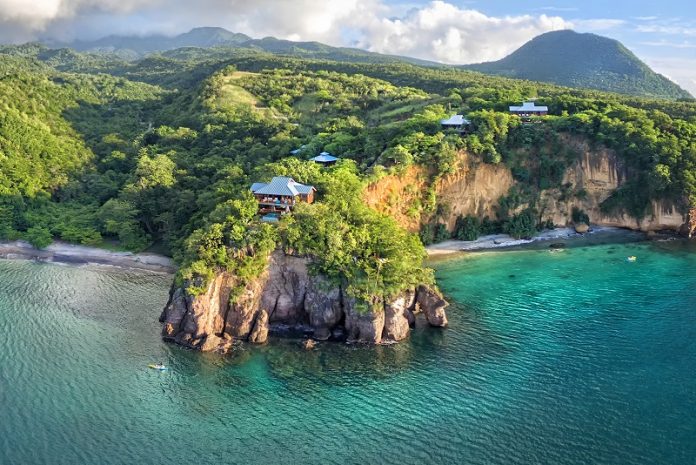
Embracing local materials, historical traditions, and climate conscious infrastructure, the Caribbean hotel industry offers an impressive selection of recreational havens artfully designed to take advantage of the region’s natural beauty and amenities.
Far from the cookie-cutter buildings with hermetically-sealed suites, basic pools, and generic “tropical” décor that you may find in some quarters, there are architectural oases throughout the islands, worthy of fervent Instagram love. For those equally awed by swooping rooflines and ocean panoramas, check out our list of gorgeous resorts with legit architectural pedigrees.
SECRET BAY HOTEL
ST. JOHN, DOMINICA
Dotting the deep Dominican rainforest with dramatic cliff views, the eco-resort Secret Bay lives up to its moniker, with an elegant series of villas and bungalows offering complete seclusion among the treetops. Conceived by famed Venezuelan architect Fruto Vivas, each luxe cabin is a work of masterful design. “We wanted guests to feel a sense of harmony within the natural environment, so we aimed to create that experience by blending the indoors with the outdoors,” Vivas says.
The structures resemble fanciful treehouses, completely clad in Guyanese hardwood and elevated from the ground by modernist concrete pillars to harness the refreshing sea winds. Inside, the tropical hardwood continues—from the plank flooring to the vaulted ceilings, while expansive windows, verandas, and balconies perfectly frame vignettes of the outdoors. The design, Vivas notes, allows “guests to feel the crosswinds, smell the aroma of the forest, and embrace a sense of freedom.”
The property’s sleek infinity pools and winding pathways beckon guests to leave their villas and explore.“Dominica is an amazing tropical paradise, and the elevation allows Secret Bay to be integrated with the external space so the landscape can penetrate the interior seamlessly.”
Ever mindful of preserving the ecosystem, the resort was built by hand, using sustainably-sourced woods, and each structure was carefully placed, avoiding as much land-clearing as possible. The result—a resort experience submerged in lush rainforest.
PARK HYATT ST. KITTS
BANANA BAY, ST. KITTS & NEVIS
Photo: Courtesy Of Park Hyatt St. Kitts
The fusion architecture of Park Hyatt St. Kitts, opened in 2017, bucks the trend of unremarkable hotel chain design, with a contemporary aesthetic inspired by the island’s historic building style, particularly its sugar plantations—from palatial great houses to modest barns.
The expansive property, overlooking Christophe Harbor, includes 126 rooms, three acclaimed restaurants, a wellness sanctuary, and the first Caribbean location of the renowned Miraval Life in Balance Spa.
Rooms and suites are housed in classic gable-roofed structures, with special suites featuring private sundecks and views of neighboring Mount Nevis. Its interiors boast a clean, white-washed style, with paneling and ceiling beams—a stark contrast to the historic opulence of the public spaces. The extraordinary Rampart terrace pairs infinity pools with massive arches built from local stone, invoking the aged stonework of nearby colonial fortress, Brimstone Hill. This stonework continues to the spa and wellness retreat’s replica sugar mill, providing an idyllic spot for yoga and meditation, with views of the sky from the circular opening above.
Even Park Hyatt’s three restaurants boast their own architectural distinction. The Fisherman’s Village recalls fishing huts and berths with its thatched roofs and open-air dining, while the exposed stone and peaked ceilings of the Stone Barn gourmet restaurant echoes the structures once used to protect crops during the rainy season. As the resort’s epicenter, with a restaurant, rum bar, library, and conservatory, The Great House takes inspiration from grand plantation houses, incorporating high ceilings and an abundance of verandas.
EL BLOK
VIEQUES, PUERTO RICO
Photo: Courtesy Of El Blok
There is a large and imposing edifice nestled among the sleepy beach bungalows in the picturesque town of Esperanza, Vieques, a small island off the coast of Puerto Rico. This stunning modernist retreat, El Blok hotel, unites minimalistic design with the Caribbean’s organic beauty. “The experience of this hotel is not about being in a pastiche or alien notion of a Caribbean that does not exist,” says El Blok’s San Juan-based architect Nataniel Fúster of Fuster + Architects. “It’s about radically embracing, reimagining and celebrating our reality…to celebrate our intense natural light, to take advantage of the open and uninterrupted spaces, and to create a tension between the user and the surroundings.”
El Blok may have raw, Brutalist bones, but its waves of gleaming white concrete echo the surrounding coastline. Inspired by the permeability of coral reefs, the façade also features moveable, perforated panels that “act like membranes,” says Fuster, providing the protection of hurricane shutters, while filtering light that casts intricate shadows in an equally striking interior. Its circular lobby is retro-modern, and its curvaceous rooms are balanced with streamlined décor. The hotel also includes subtle nods to classic Spanish-Caribbean architecture, with colorful tilework and an open atrium that circulates fresh air and light.
Completed in 2014, El Blok is not just celebrated for its distinctive design, its reinforced structure weathered 2017’s Hurricane Maria without significant damage. The hotel grounds played an active part in the island’s recovery and has become a place of refuge for locals and tourists alike, thanks to its lively (and legendary) rooftop, with an infinity pool, entertainment space, and uninterrupted ocean vistas.
TRIDENT CASTLE AND HOTEL
PORT ANTONIO, JAMAICA
Photos: Courtesy Of Trident Castle
Turn a certain corner around Pegg Point in Port Antonio, Jamaica and you’ll suddenly be greeted by a fairytale castle, complete with towering turrets, Juliet balconies, and a grand staircase leading downward to the sea. It is bright white, majestic, and—if you’re seeing it for the first time—totally unexpected. Designed by Jamaican architect Earl Levy as a private residence, which eventually became his own home, Trident Castle captures the old-world elegance of classic British Colonial architecture.
The grandiose banquet hall has 47-foot ceilings, neo-classical accents and a checkerboard floor. The Castle’s glamorous entertainment spaces also include a traditional dining room featuring regal arches and decorative plaster friezes, as well as sweeping terraces with iconic black-and-white tilework.
Built in the 1980s, the castle now serves as an exclusive venue for weddings and other special events, and at times as a vacation retreat for Hollywood stars and music royalty.
Photos: Courtesy Of Trident Castle
Nestled on the same property is the luxurious Trident Hotel, which Levy originally designed. In 2012, after both buildings came under new ownership, Kingston-based architect Vidal Downing and his team at Atelier Vidal remodeled the hotel. In a nod to Trident Castle’s traditional architecture, the team sought to marry the boutique hotel’s classic style with a more contemporary sensibility. The goal, Downing says, “was to change how the building related to the outdoors. We wanted to reconnect you to the view, stripping away any distractions.” The new exteriors mirrored the castle’s Jamaican Georgian architecture, with gabled roofs and symmetrical wings, but entrances and openings were expanded to “always bring your eyes back to the ocean,” he adds. The overhaul incorporated elements of tropical contemporary design with sleek façades—a minimalist style that continues to the modern terraces with infinity pools.






























































